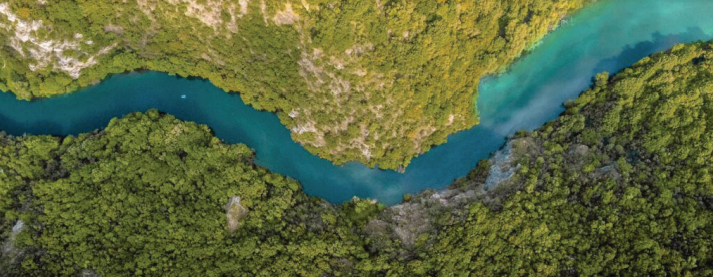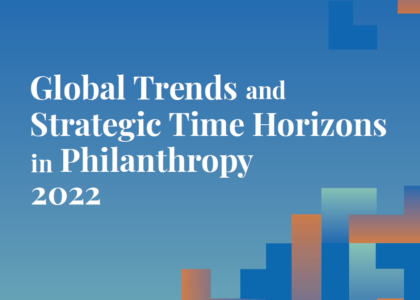Strategic Time Horizon Case Study: MAVA Foundation’s Time-Limited Journey
June 23, 2023
This publication is part of Rockefeller Philanthropy Advisors’ multi-year research initiative exploring the various dimensions and considerations of strategic time horizons in philanthropy. To learn more about Strategic Time Horizons, click here.
Background
Founded in 1994 by Luc Hoffmann, a renowned Swiss businessman and environmentalist, the MAVA Foundation has its roots in its founder’s keen interest in waterbirds in the Mediterranean. From there it expanded its focus to work on ecosystems, particularly in freshwater and marine environments in the Mediterranean, West Africa and Switzerland. Later it added in a stream of work looking at the root causes of biodiversity loss with the aim to create an economic system that values people, planet and profit. The foundation was driven by Mr. Hoffmann’s mission to protect biodiversity, promote the sustainable use of natural resources, and build resilient societies. Mr. Hoffmann presided the foundation until 2010 until he handed over the reins to his son André Hoffmann.
The founder did not wish to create a permanent institution that his heirs would need to carry on in his image. Thus he planned for the eventual closure long in advance, with a belief that it is important to provide freedom and space for future generations to set their own visions and adapt to changing needs. Although it was known that the foundation would eventually close, foundation leadership began its detailed planning for the closure in 2015.
Since it did not have an endowment, instead relying on corporate dividends for its income stream, MAVA was not technically a spend-down foundation. Its limited-life approach provides an illuminating example for giving vehicles that fall outside of the endowed foundation formula but are looking to leverage the strategic clarity of time-limited philanthropy. With the organization’s closure set for June 2023, the foundation understood that significant changes internally and externally would be required, and acted on them intentionally and strategically.
MAVA’s Internal Journey: Developing a New Drawing Board
Supporting and Preparing Staff
The MAVA Foundation began its time-limited journey by engaging in rigorous planning to guide the transition. At the same time, it intentionally retained agility and flexibility, understanding that those capabilities would be imperative to the success of the transition. As one of the earliest steps in the process, the foundation’s leadership engaged with staff to allay fears and anxieties natural to such decisions, as well as to understand how it can best meet staff needs. It was essential to provide staff with a sense of security and peace of mind. This early and open communication also helped alleviate personal uneasiness related to closing and allowed staff to focus fully on engaging with partners to ensure a smooth closure.
From the beginning, MAVA’s leadership believed it was essential to have open and honest conversations about the future, even if it meant confronting uncomfortable truths. It recognized that the transition would be challenging for staff as it impacted people’s careers, sense of self and material wellbeing. A plan, including financial payouts, was created for staff years in advance, ensuring that all staff were taken care of and had ample time to find out their next direction. For example, the foundation’s CEO, Lynda Mansson, made a commitment to the staff to provide them with a 12 months’ notice before their jobs ended. While implementing the transition package required persuasion to get all stakeholders to agree, Mansson’s efforts were supported by a longstanding trust-based relationship with board members
Enabling Effective Communications
The MAVA Foundation recognized that consistency of message was essential to managing the time-limited transition effectively. It understood that if staff and stakeholders heard different things, it would create confusion, reinforce anxieties and undermine trust in the organization. To achieve this, the foundation created talking points and key messages for board members and staff to ensure that everyone’s public-facing statements were reliable and harmonious. Staff members also participated in role play exercises to ensure that they were comfortable with the key messages and talking points.
Walking the Walk Responsibly and Responsively: Centering Grantees and the Ecosystem
Inclusive, Open Communications with Grantees
MAVA’s approach to communications with its grantees was critical to ending its lifespan and achieving its objectives responsibly and equitably. The foundation appreciated the importance of open communications and responsive interventions, and intentionally avoided imposing its priorities on grantees. Instead, it always started with the question “what do you need, and how can we support you?” This approach seeded trust, allowing for open and honest conversations about what the foundation’s limited lifespan meant for the field. It was also the top question the foundation posed to its grantees as it announced its new, truncated timeline.
To ensure a lasting impact beyond its lifetime, the MAVA Foundation leaned deeper into its existing strategy of investing in its grantees to build their capacity and sustainability. To achieve this, the foundation continued to provide long-term and flexible funding to organizations, invested in organizational development, and supported fundraising efforts. CEO Lynda Mansson believes this strategy was a resounding success and should be adopted by funders across all strategic time horizons. “I think one of the biggest learnings out of this is investing in capacity and sustainability of your partners pays off. Even if you’re not ending, everybody should do it.”
Securing Grantees’ Longevity
As a well-respected member of the philanthropic community, the foundation was frequently approached to recommend organizations for funder support. It was happy to further leverage such opportunities after its decision to switch to a timelimited lifespan to give grantees a better chance of longevity. By having close relationships and a deep understanding of its grantees, the foundation was well positioned to assess the alignment between these organizations and potential new funders, and make effective, lasting recommendations.
Investing in the Field
Even prior to its decision to become a time-limited foundation, MAVA was known for its generous, long-term funding of difficult-to-fund initiatives. Following the decision, its drive to strengthen the field came into sharper focus. The foundation believed investing in the capacity and sustainability of its partners was core to achieving sustainability in the conservation field. To walk the walk on this commitment, the foundation undertook a key initiative and created an online fundraising course, available for anyone to use on the Acumen Academy platform.
The course, which has been completed by over 13,000 people, provides participants with the skills and knowledge needed to secure funding for conservation initiatives. The course has been particularly valuable for the foundation’s partners. By providing its partners with the skills and knowledge needed to secure funding, the foundation has contributed to the sustainability of the conservation field. It has helped to ensure that its partners are able to continue their critical work even after the foundation’s funding has ended.
Responsiveness in Unprecedented Times: How COVID-19 Impacted MAVA Foundation’s Closure Plans
The COVID-19 pandemic presented significant challenges for the MAVA Foundation and its partners. With field sites shutting down and work becoming impossible, the foundation had to pivot quickly and adjust its plans. The foundation prioritized staff employment and maintaining flexibility during this time.
To support its partners during this difficult time, the foundation allowed for flexibility in redirecting funds and provided emergency grants to those in need. These emergency grants were distributed quickly to ensure that organizations could continue their critical work. The foundation also had a midterm evaluation at this time, which allowed them to assess the situation and adapt the plan based on what had already been accomplished and what was currently going on.
The foundation had to roll back on some of its ambitions due to the pandemic, but in most cases, it was able to maintain its ambition levels. It rearranged budgets underneath to reach its goals in another way. The foundation had a list of “must wins” into which it put extra investments into to ensure that they happened.
The emergency grants did not erode what was planned under the regular strategy, but additional funds were made available to support the organizations in need. The foundation’s quick response and flexibility allowed its partners to continue their work and maintain their impact during a challenging time. The foundation’s commitment to its partners and its willingness to adapt its plans to the changing circumstances highlights the importance of collaboration and communication in philanthropy.
Learning on the Job: Curating Insights, Sharing Lessons Learned
Harvesting Knowledge, Preserving its Story
The foundation placed a significant emphasis on harvesting and sharing its learnings with the conservation community, peer funders and the broader philanthropic ecosystem. To that end, MAVA created a legacy website featuring all of its milestones, learnings, publications and historic documents. The website ensures that the foundation’s work and learnings are available for today’s peer funders looking to learn from its experience, as well as for future generations. In a continued showcase of its commitment to transparency, the foundation put a concentrated effort into preserving and communicating its history, including a publicly available archive of all its documents and internal materials, such as meeting notes and reports. The archive ensures that the foundation’s history is not lost and can be used by researchers, scholars and practitioners in the future.
Lessons Learned
In addition to a curated set of historic publications and documents, the foundation believed it is important to share practical lessons learned in the process of successfully closing a well-established philanthropic operation. Through its experiences, MAVA extracted three major lessons which will prove informative to others on a similar journey:
Lessons 1: Embracing Contingency Planning
Mansson noted that contingency planning was critical in ensuring a smooth transition for the MAVA Foundation. The foundation’s leaders knew that the transition would be challenging, and that staff might start leaving if the right opportunity came along. Mansson notes that she always told people what kept her up at night: “What am I going to do if people leave too early?” To address this concern, Mansson developed several back-up plans. She identified consultants who knew the foundation well enough to step in if needed and emphasized the importance of putting trust in staff.
The foundation offered staff opportunities to develop new skills and knowledge through training, professional development and new assignments. In exchange for the guarantee of 12 months’ notice before the end of employment, all staff were expected to be flexible in their work assignments and to play a hands-on role in some aspect of the closure. By investing in this contingency plan, the foundation was able to ensure a smooth transition when staff started leaving.
Lesson 2: Less Cliff, More Slope.
Another important lesson Lynda Mansson carries with her is that if she had to do it again is engaging in incremental, sequential change. In other words, she would “slope it much more.” This means acting with a more paced, incremental cadence, and ending one program at a time, rather than abruptly or en masse. Mansson believes this approach would allow for natural attrition in staff, making the transition much more manageable.
Lesson 3: The Critical Role of Robust Administration – a Key Capability
Additionally, the foundation called out the critical role a strong administrative team plays in ensuring a streamlined, successful time horizon transition. This is because of comprehensive changes related to the foundation’s operations, including logistical considerations such as closing down office space, forwarding phone numbers, and countless other details. A smooth closure is simply impossible without an efficient administrative capability.
Looking Back Over Its Shoulder
The MAVA Foundation’s fresh time-limited journey serves as an estimable reminder that while time horizon change can be difficult, a clear vision, intent and painstaking planning are key components of success. The foundation’s decision to transition to a limited-life organization was a bold move that required significant changes in its approach to philanthropy. Its thoughtful, transparent, and human-centered approach means that its work will continue to live on through the organizations it supported and helped grow, the connections it made in the ecosystem, and the lessons learned and shared publicly. By making strong investments in internal staff so they were able to feel supported and work to prioritize the sustainability of its grantees the foundation was able to achieve lasting impact beyond its lifetime.
Each step MAVA Foundation took throughout the process of closing the foundation was rooted in care for its mission, its partners, and the ecosystem. That is part of what made it so successful. Mansson said that she was often told by various stakeholders that grantee partners and internal staff alike, “know the MAVA Foundation is going take good care of them.” Her response was this: “I believe we have lived up to that promise.”
Back to News


